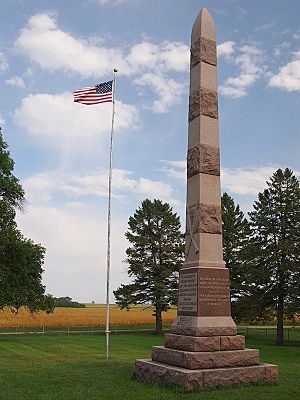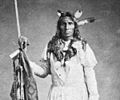Battle of Wood Lake facts for kids
Quick facts for kids Battle of Wood Lake |
|||||||
|---|---|---|---|---|---|---|---|
| Part of the Dakota War of 1862, American Civil War | |||||||
 Location of the Sioux positions along the bluffs north of the Minnesota Volunteers' camp |
|||||||
|
|||||||
| Belligerents | |||||||
| Santee Sioux | |||||||
| Commanders and leaders | |||||||
| Col. Henry Hastings Sibley | Chief Little Crow | ||||||
| Strength | |||||||
| 1169–2000 | 700–1200 | ||||||
| Casualties and losses | |||||||
| 7 killed 34 wounded |
7–15 killed | ||||||
The Battle of Wood Lake was an important fight during the Dakota War of 1862. It happened in September of that year. By this time, the Dakota people's attacks had slowed down. Forces from Minnesota were starting to follow a plan made by Governor Alexander Ramsey. This plan, carried out by Colonel Henry Hastings Sibley, aimed to free European-American settlers who were being held captive by the Dakota. It also aimed to move the Dakota people out of the state.
Contents
Why the Battle Happened
In early September, Colonel Sibley tried to talk with Chief Little Crow. Sibley thought the Dakota might be tired of fighting. Little Crow replied, explaining why the war began. He also hinted that he might talk about releasing some American prisoners.
Sibley refused to negotiate. He demanded that Little Crow and his people surrender. Little Crow would not surrender. This set the stage for another big battle.
Sibley's journey from Fort Snelling included about 1,400 soldiers. It took almost nine days to reach Fort Ridgely. At Fort Ridgely, Sibley waited even longer. This made many settlers upset, as they wanted quick action against the Dakota.
The delay happened for a few reasons. Many of Sibley's soldiers were new and had little experience. Also, there was a shortage of basic supplies. These included guns, ammunition, and horses. These supplies finally reached Sibley's forces between September 11 and 14. On September 19, the troops began marching up the Minnesota River valley.
The Battle Begins
The soldiers set up camp east of a small lake. This lake was called Lone Tree or Battle Lake. It was about five miles north of what is now Echo, Minnesota. Sibley's guide thought this was Wood Lake. Because of this mistake, the battle got the wrong name.
The Third Minnesota regiment camped on a ridge south of a creek. The Sixth Minnesota was next to the small lake. The Seventh Minnesota was at the back, behind the creek's valley. All the soldiers, along with their wagons and cannons, were partly protected by trenches.
Chief Little Crow planned to surprise the soldiers. He wanted to attack them the next morning while they were marching. He knew that soldiers spread out on a road would be easy targets.
However, the battle started differently. In the morning, some soldiers from the Third Minnesota regiment left camp early. They were in wagons, looking for food near the Upper Sioux Agency. Some of these wagons went off the road. They drove straight towards some of Little Crow's men hiding in the grass. The Dakota warriors had to stand up and fire. This unexpected event started the fight.
Experienced soldiers from the Third Regiment quickly ran to help their friends. They had recently returned from fighting in the south. The Renville Rangers also helped them. They moved about half a mile from the camp. But then, Dakota warriors threatened both sides of their line.
Colonel Sibley ordered Lieutenant Colonel William R. Marshall to move forward. Marshall had six companies and a cannon. Their job was to push back the Dakota on the right side. On the left side, Major Robert N. McLaren led his men around the lake. They stopped an attempt by the Dakota to attack from the side.
The battle lasted about two hours. During the fighting, Chief Mankato was killed by a cannonball.
After the Battle
The battle was a clear victory for the United States. The Dakota suffered many losses. For his part in the battle, Sibley was promoted to Brigadier General.
Because of the heavy losses and Chief Mankato's death, this was the last major battle fought by the Dakota in the uprising. After this, the influence of chiefs who wanted peace grew stronger. They helped arrange for the release of European Americans held captive by the Dakota. Many Dakota also surrendered at Camp Release.
Military Units Involved
During the Dakota War of 1862, Minnesota did not have many soldiers. So, units were often sent out as soon as they could be formed. Sometimes, parts of companies were assigned to different groups. Units that fought in this battle included:
- The 3rd Minnesota Infantry
- The 6th Minnesota Infantry
- The 7th Minnesota Infantry
- The 9th Minnesota Infantry
- The 10th Minnesota Infantry
- Citizen Soldier units and local groups like the "Renville Rangers"
- An artillery unit with a 6-pound cannon
Protecting the Battlefield
In 2010, the battlefield site was added to the National Register of Historic Places. It is known as the Wood Lake Battlefield Historic District. It was recognized for its importance to Minnesota and the Dakota people. It was also noted for early efforts to remember the battle, like the stone monument built between 1907 and 1910.
The Civil War Trust (now part of the American Battlefield Trust) and its partners have helped save 240 acres of the Wood Lake battlefield.
Images for kids





